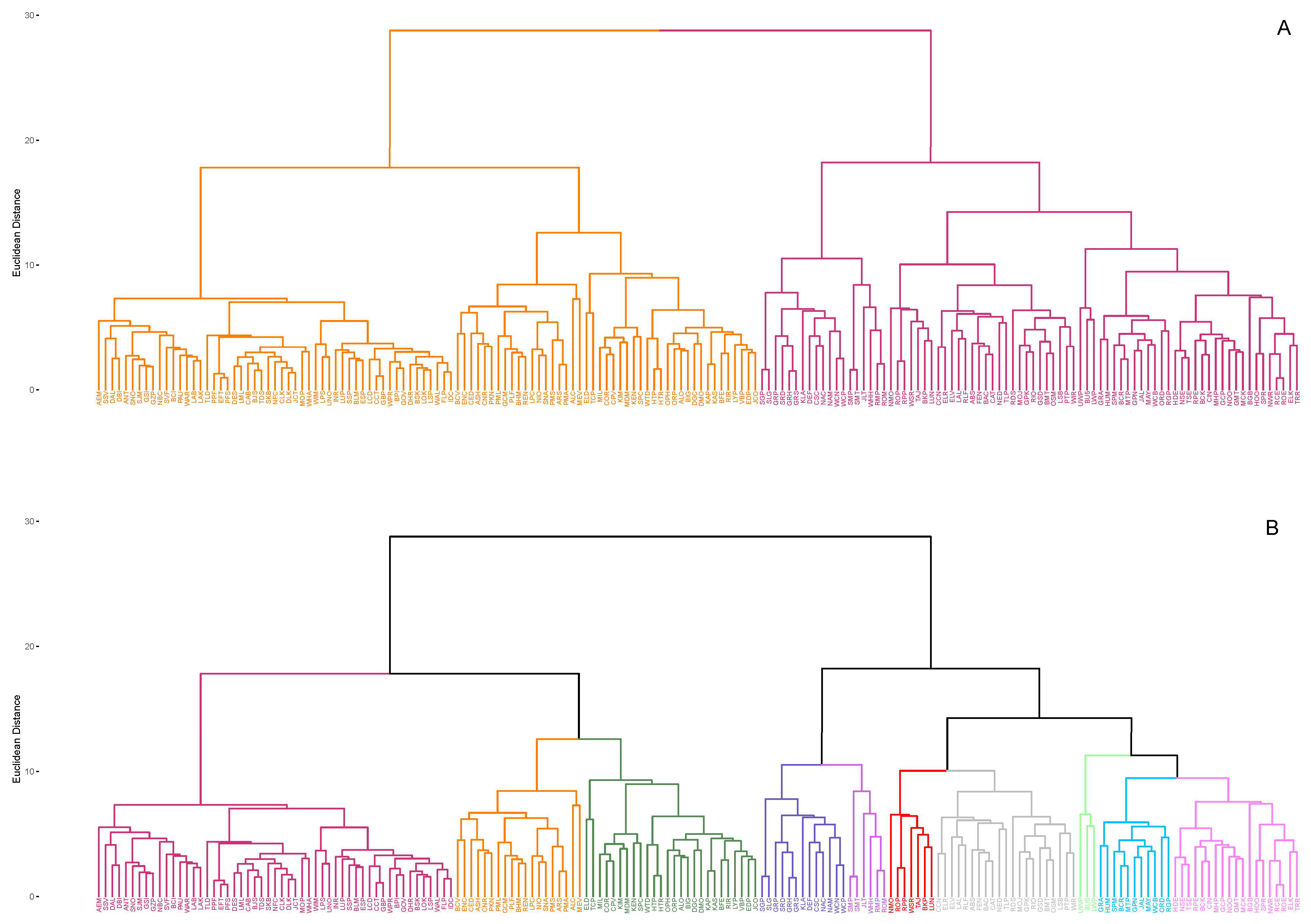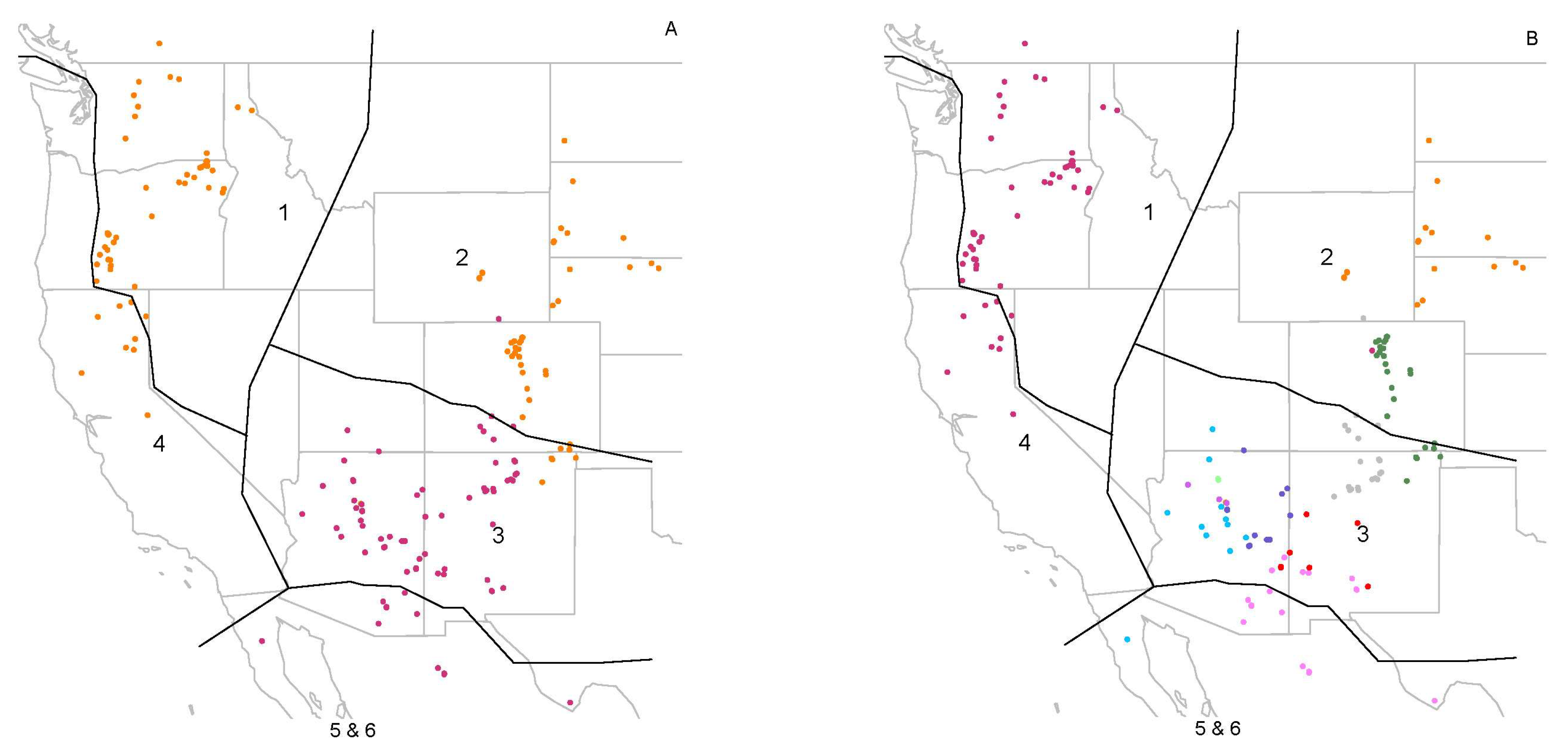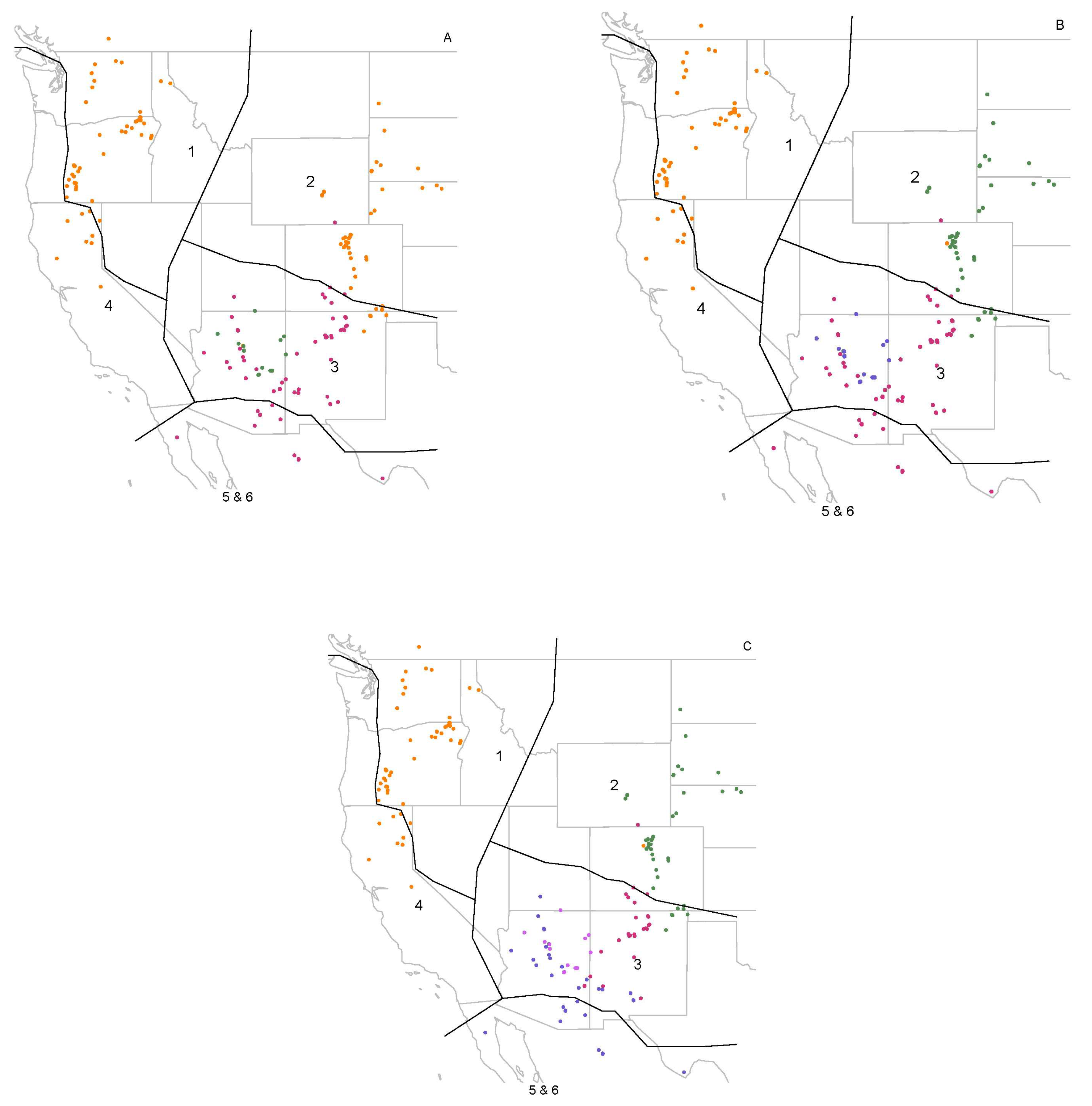Environmental Factors Driving Diversification of Ponderosa Pine in the Western United States
Abstract
1. Introduction
2. Materials and Methods
3. Results
4. Discussion
5. Conclusions
Supplementary Materials
Author Contributions
Funding
Data Availability Statement
Acknowledgments
Conflicts of Interest
References
- Wang, C.W. Genetics of Ponderosa Pine; USDA Forest Service Research Paper WO-34; USDA: Washington, DC, USA, 1977; 24p.
- Jaramillo-Correa, J.P.; Beaulieu, J.; Khasa, D.P.; Bousquet, J. Inferring the past from the present phylogeographic structure of North American forest trees: Seeing the forest for the genes. Can. J. For. Res. 2009, 39, 286–307. [Google Scholar] [CrossRef]
- Fritts, H.C. Tree-Rings and Climate; Academic Press: London, UK, 1976; 567p. [Google Scholar]
- Swetnam, T.W.; Baisan, C.H. Fire Histories of Montane Forests in the Madrean Borderlands; Forest Service General Technical Report RM; United States Department of Agriculture: Washington, DC, USA, 1996; pp. 15–36.
- Swetnam, T.W.; Betancourt, J.L. Fire-southern oscillation relations in the southwestern United States. Science 1990, 249, 1017–1020. [Google Scholar] [CrossRef]
- Speer, J.H. Fundamentals of Tree-Ring Research; University of Arizona Press: Tucson, AZ, USA, 2010; 333p. [Google Scholar]
- Arno, S.F.; Sneck, K.M. A Method for Determining Fire History in Coniferous Forests of the Mountain West; Department of Agriculture, Forest Service, Intermountain Forest and Range Experiment Station: Ogden, Utah, 1977; Volume 42.
- Speer, J.H.; Swetnam, T.W.; Wickman, B.E.; Youngblood, A. Changes in pandora moth outbreak dynamics during the past 622 years. Ecology 2001, 823, 679–697. [Google Scholar] [CrossRef]
- Critchfield, B.W.; Little, E.L. Geographic Distribution of the Pines of the World; USDA Forest Service Miscellaneous Publication 991; USDA: Washington, DC, USA, 1966.
- USGS Digital Representation of “Atlas of United States Trees” by Elbert L. Little, Jr. U.S. Geological Survey. 1999. Available online: https://www.fs.usda.gov/database/feis/pdfs/Little/aa_SupportingFiles/LittleMaps.html (accessed on 1 July 2024).
- Fiedler, C.E.; Arno, S.F. Ponderosa: People, Fire, and the West’s Most Iconic Tree; Mountain Press Publishing Company: Missoula, MT, USA, 2015. [Google Scholar]
- Potter, K.M.; Hipkins, V.D.; Mahalovich, M.F.; Means, R.E. Mitochondrial DNA haplotype distribution patterns in Pinus ponderosa (Pinaceae): Range-wide evolutionary history and implications for conservation. Am. J. Bot. 2013, 1008, 1562–1579. [Google Scholar] [CrossRef] [PubMed]
- Willyard, A.; Gernandt, D.S.; Potter, K.; Hipkins, V.; Marquardt, P.; Mahalovich, M.F.; Langer, S.K.; Telewski, F.W.; Cooper, B.; Douglas, C.; et al. Pinus ponderosa: A checkered past obscured four species. Am. J. Bot. 2017, 1041, 161–181. [Google Scholar] [CrossRef] [PubMed]
- Shinneman, D.J.; Means, R.E.; Potter, K.M.; Hipkins, V.D. Exploring climate niches of ponderosa pine (Pinus ponderosa Douglas ex Lawson) haplotypes in the western United States: Implications for evolutionary history and conservation. PLoS ONE 2016, 11, e0151811. [Google Scholar] [CrossRef]
- Sousa, W.P. The role of disturbance in natural communities. Annu. Rev. Ecol. Syst. 1984, 15, 353–391. [Google Scholar] [CrossRef]
- Parminter, J.; Daigle, P. Landscape Ecology and Natural Disturbances; Extension Note 10; Ministry of Forests Research Program: Vancouver, BC, Canada, 1997.
- McCullough, D.G.; Werner, R.A.; Neumann, D. Fire and insects in northern and boreal forest ecosystems of North America. Annu. Rev. Entomol. 1998, 43, 107–127. [Google Scholar] [CrossRef] [PubMed]
- Fleming, R.A.; Candau, J.-N.; McAlpine, R.S. Landscape-scale analysis of interactions between insect defoliation and forest fire in central Canada. Clim. Chang. 2002, 55, 251–272. [Google Scholar] [CrossRef]
- Swetnam, T.W.; Baisan, C.H. Tree-ring reconstructions of fire and climate history in the Sierra Nevada and the southwestern United Sates, In Fire and Climatic Change in Temperate Ecosystems of the Western Americas; Veblen, T.T., Baker, W.L., Montenegro, G., Swetnam, T.W., Eds.; Springer: Berlin/Heidelberg, Germany, 2003; pp. 154–191. [Google Scholar]
- Delcourt, H.R.; Delcourt, P.A. Quaternary landscape ecology: Relevant scales in space and time. Landsc. Ecol. 1988, 2, 23–44. [Google Scholar] [CrossRef]
- Thompson, J.N. Specific hypotheses on the geographic mosaic of coevolution. Am. Nat. 1999, 153, S1–S14. [Google Scholar] [CrossRef]
- Picket, S.T.A.; White, P.S. Natural Disturbance and Patch Dynamics; Academic Press: Cambridge, MA, USA, 1985. [Google Scholar]
- Seymour, R.S.; White, A.S.; de Maynadier, P.G. Natural disturbance regimes in northeastern North America—Evaluating silvicultural systems using natural scales and frequencies. For. Ecol. Manag. 2002, 1551, 357–367. [Google Scholar] [CrossRef]
- Wickman, B.E. Forest health in the Blue Mountains: Influences of insects and disease. In Forest Health in the Blue Mountains: Science Perspectives; General Technical Reports PNW-GTR-310; Quigley, T.M., Ed.; U.S. Department of Agriculture, Forest Service, Pacific Northwest Research Station: Portland, OR, USA, 1992. [Google Scholar]
- Swanson, F.J.; Jones, J.A.; Wallin, D.O.; Cissel, J.H. Natural variability-implications for ecosystem management. In Ecosystem Management: Principles and Applications; General Technical Reports PNW-GTR-318; Jensen, M.E., Bourgeron, P.S., Eds.; U.S. Department of Agriculture, Forest Service, Pacific Northwest Research Station: Portland, OR, USA, 1994; Volume 2, pp. 89–103. [Google Scholar]
- Lafon, C.W.; Speer, J.H. Using Dendrochronology to identify major ice storm events in oak forests of southwestern Virginia. Clim. Res. 2002, 20, 41–54. [Google Scholar] [CrossRef]
- Speer, J.H.; Kulakowski, D. Creating a buzz: Insect outbreaks and disturbance interactions. In Dendroecology: Tree-Ring Analyses Applied to Ecological Studies; Springer: Berlin, Germany, 2017; pp. 231–255. [Google Scholar]
- Taylor, S.W.; Carroll, A.L.; Alfaro, R.I.; Safranyik, L. Forest, climate and mountain pine beetle outbreak dynamics in western Canada. In The Mountain Pine Beetle: A Synthesis of Biology, Management, and Impacts on Lodgepole Pine; Safranyik, L., Wilson, B., Eds.; Natural Resources Canada, Canadian Forest Service, Pacific Forestry Centre: Victoria, BC, Canada, 2006; pp. 67–84. [Google Scholar]
- Speer, J.H. A Dendrochronological Record of Pandora Moth (Coloradia pandora, Blake) Outbreaks in Central Oregon. Master’s Thesis, The University of Arizona, Tucson, AZ, USA, 1997. [Google Scholar]
- Speer, J.H.; Holmes, R.L. Effects of pandora moth outbreaks on ponderosa pine wood volume. Tree-Ring Res. 2004, 60, 69–76. [Google Scholar] [CrossRef]
- Clark, P.W.; Speer, J.H.; Winship, L.J. Identifying and separating Pandora moth outbreaks and climate from a 1500-year Ponderosa pine chronology from Central Oregon. Tree-Ring Res. 2017, 73, 113–125. [Google Scholar] [CrossRef]
- Patterson, J.E. The pandora Moth, a Periodic Pest of the Western Pine Forests; Technical Bulletin; U.S. Department of Agriculture, Forest Service: Washington, DC, USA, 1929; Volume 137, 20p.
- Wygant, N.D. An infestation of the pandora moth, Coloradia pandora Blake, in lodgepole pine in Colorado. J. Econ. Entomol. 1941, 34, 697–702. [Google Scholar] [CrossRef]
- Carolin, V.M.; Knopf, J.A.E. The Pandora Moth; Forest Pest Leaflet 114; U.S. Department of Agriculture, Forest Service: Washington, DC, USA, 1968; 7p.
- Furniss, R.L.; Carolin, V.M. Western Forest Insects; U.S. Department of Agriculture, Forest Service: Washington, DC, USA, 1977; 654p.
- Morgan, P.; Aplet, G.H.; Haufler, J.B.; Humphries, H.C.; Margaret, M.M.; Wilson, W.D. Historical range of variability: A useful tool for evaluating ecosystem change. In Assessing Forest Ecosystem Health in the Inland West; Proceedings of the American Forests Scientific Workshop; Sampson, R.L., Adams, D.L., Eds.; The Hawthorn Press, Inc.: New York, NY, USA, 1994; pp. 87–111. [Google Scholar] [CrossRef]
- Wright, S. The genetical structure of populations. Ann. Eugen. 1951, 15, 323–354. [Google Scholar] [CrossRef]
- Nei, M. F-statistics and analysis of gene diversity in subdivided populations. Ann. Hum. Genet. 1977, 41, 225–233. [Google Scholar] [CrossRef]
- Weir, B.S.; Cockerham, C.C. Estimating F-statistics for the analysis of population structure. Evolution 1984, 38, 1358–1370. [Google Scholar] [CrossRef]
- Excoffier, L.; Smouse, P.E.; Quattro, J.M. Analysis of molecular variance inferred from metric distances among DNA haplotypes: Application to human mitochondrial DNA restriction data. Genetics 1992, 131, 479–491. [Google Scholar] [CrossRef]
- Chung, M.Y.; Nason, J.D.; Epperson, B.K.; Chung, M.G. Temporal aspects of the fine scale genetic structure in a population of Cinnamomum insularimontanum (Lauraceae). Heredity 2003, 90, 98–106. [Google Scholar] [CrossRef] [PubMed]
- Gustine, D.L. Spatial autocorrelation analysis of genetic structure within white clover populations. In Molecular Breeding of Forage and Turf; Hopkins, A., Wang, Z.Y., Mian, R., Sledge, M., Barker, R.E., Eds.; Springer: Dordrecht, The Netherlands, 2004; pp. 309–314. [Google Scholar]
- Franks, S.J.; Richards, C.L.; Gonzales, E.; Cousins, J.E.; Hamrick, J.L. Multi-scale analysis of Uniola paniculata (Poaceae): A coastal species with a linear, fragmented distribution. Am. J. Bot. 2004, 91, 1345–1351. [Google Scholar] [CrossRef]
- Openshaw, S. The modifiable areal unit problem. Concepts Tech. Mod. Geogr. 1984, 38, 41. [Google Scholar]
- Unwin, D.J. GIS, spatial analysis and spatial statistics. Prog. Hum. Geogr. 1996, 20, 540–551. [Google Scholar] [CrossRef]
- Manel, S.; Schwartz, M.K.; Luikart, G.; Taberlet, P. Landscape genetics: Combining landscape ecology and population genetics. Trends Ecol. Evol. 2003, 18, 189–197. [Google Scholar] [CrossRef]
- Holderegger, R.; Wager, H.H. A brief guide to landscape genetics. Landsc. Ecol. 2006, 21, 793–796. [Google Scholar] [CrossRef]
- Storfer, A.; Murphy, M.A.; Evans, J.S.; Goldberg, C.S.; Robinson, S.; Spear, S.F.; Dezzani, R.; Delmelle, E.; Vierling, L.; Waits, L.P. Putting the ‘landscape’ in landscape genetics. Heredity 2007, 98, 128–142. [Google Scholar] [CrossRef] [PubMed]
- Piovesan, G.; Biondi, F.; Bernabei, M.; Filippo, A.D.; Schirone, B. Spatial and altitudinal bioclimatic zones of the Italian peninsula identified from a beech (Fagus sylvatica L.) tree-ring network. Acta Oecologica 2005, 27, 197–210. [Google Scholar] [CrossRef]
- Holmes, R.L. Quality Control of Crossdating and Measuring. Users Manual for Computer Program COFECHA. Tree-Ring Chronologies of Western North America: California, Eastern Oregon and Northern Great Basin. 1986. Available online: https://repository.arizona.edu/handle/10150/304672 (accessed on 1 July 2024).
- Cook, E.R.; Meko, D.M.; Stahle, D.W.; Cleaveland, M.K. Drought reconstructions for the continental United States. J. Clim. 1999, 12, 1145–1162. [Google Scholar] [CrossRef]
- Hastie, T.; Friedman, J.; Tibshirani, R. Unsupervised Learning. In The Elements of Statistical Learning; Springer Series in Statistics; Springer: New York, NY, USA, 2001. [Google Scholar] [CrossRef]
- Forgy, E.W. Cluster analysis of multivariate data: Efficiency versus interpretability of classifications. Biometrics 1965, 21, 768–769. [Google Scholar]
- Ward, J.H. Hierarchical Grouping to Optimize an Objective Function. J. Am. Stat. Assoc. 1963, 58, 236–244. [Google Scholar] [CrossRef]
- Suzuki, R.; Shimodaira, H. An application of multiscale bootstrap resampling to hierarchical clustering of microarray data: How accurate are these clusters. In The Fifteenth International Conference on Genome Informatics; Pacifico Convention Plaza Yokohama: Yokohama, Japan, 2004; Volume 34, Available online: http://stat.sys.i.kyoto-u.ac.jp/titech/pub/GIW2004/GIW04P034.pdf (accessed on 1 July 2024).
- Thorndike, R.L. Who belongs in the family? Psychometrika 1953, 18, 267–276. [Google Scholar] [CrossRef]
- Suzuki, R.; Terada, Y.; Shimdiara, H. Pvclust: Heirarchal Clustering with p-Values via Multiscale Bootstrap Resampling. R Package Version 2.2-0. 2019. Available online: https://CRAN.R-project.org/package=pvclust (accessed on 1 July 2024).
- R Core Team. R: A Language and Environment for Statistical Computing; R Foundation for Statistical Computing: Vienna, Austria, 2019; Available online: https://www.R-project.org/ (accessed on 1 July 2024).
- Banfield, J.D.; Adrian, E. Raftery. Model-Based Gaussian and Non-Gaussian Clustering. Biometrics 1993, 49, 803–821. [Google Scholar] [CrossRef]



Disclaimer/Publisher’s Note: The statements, opinions and data contained in all publications are solely those of the individual author(s) and contributor(s) and not of MDPI and/or the editor(s). MDPI and/or the editor(s) disclaim responsibility for any injury to people or property resulting from any ideas, methods, instructions or products referred to in the content. |
© 2024 by the authors. Licensee MDPI, Basel, Switzerland. This article is an open access article distributed under the terms and conditions of the Creative Commons Attribution (CC BY) license (https://creativecommons.org/licenses/by/4.0/).
Share and Cite
Speer, J.H.; Heyman, M. Environmental Factors Driving Diversification of Ponderosa Pine in the Western United States. Land 2024, 13, 1428. https://doi.org/10.3390/land13091428
Speer JH, Heyman M. Environmental Factors Driving Diversification of Ponderosa Pine in the Western United States. Land. 2024; 13(9):1428. https://doi.org/10.3390/land13091428
Chicago/Turabian StyleSpeer, James H., and Megan Heyman. 2024. "Environmental Factors Driving Diversification of Ponderosa Pine in the Western United States" Land 13, no. 9: 1428. https://doi.org/10.3390/land13091428
APA StyleSpeer, J. H., & Heyman, M. (2024). Environmental Factors Driving Diversification of Ponderosa Pine in the Western United States. Land, 13(9), 1428. https://doi.org/10.3390/land13091428




